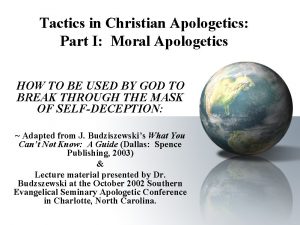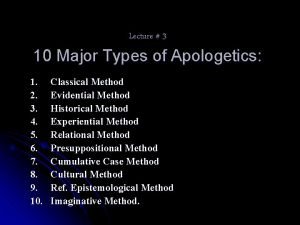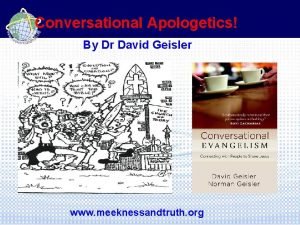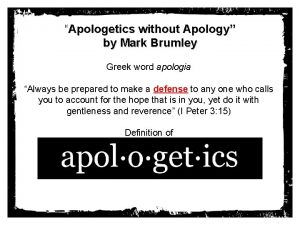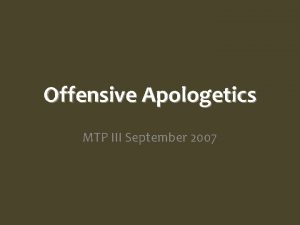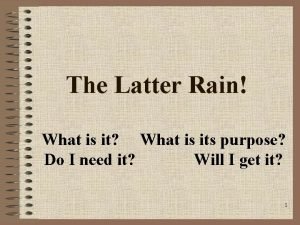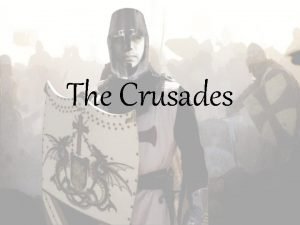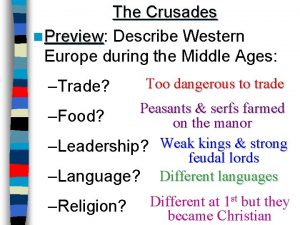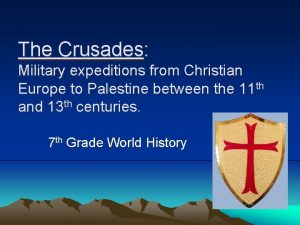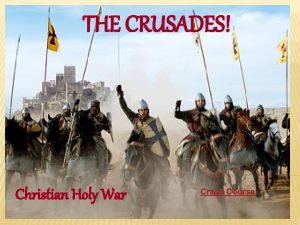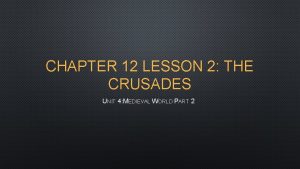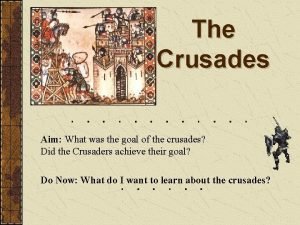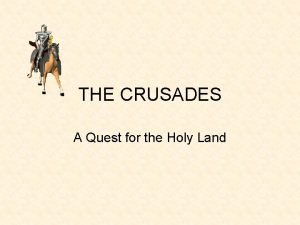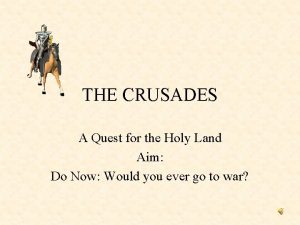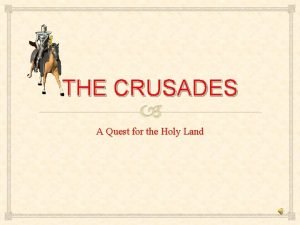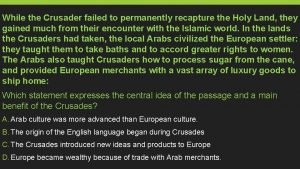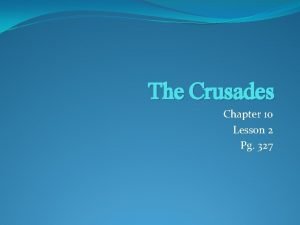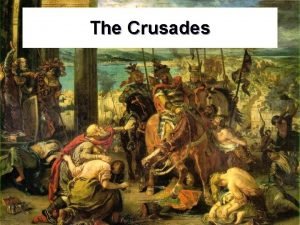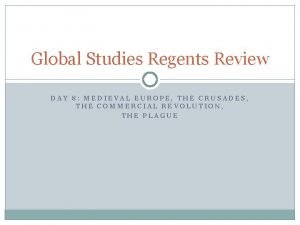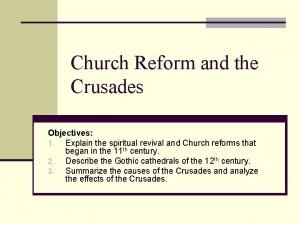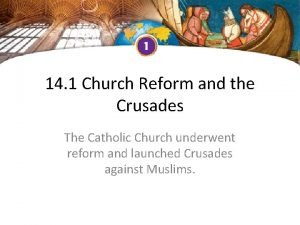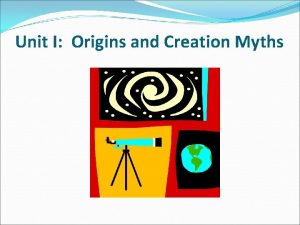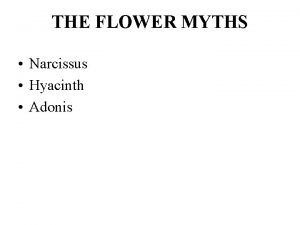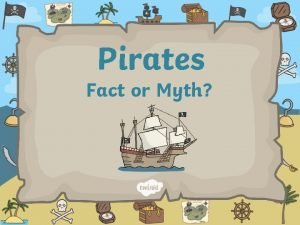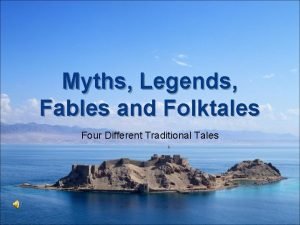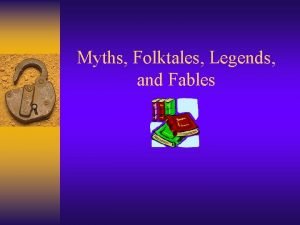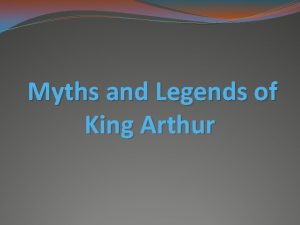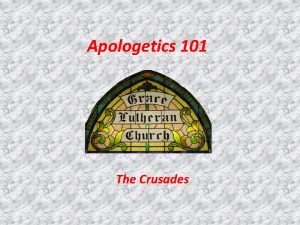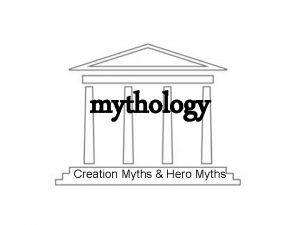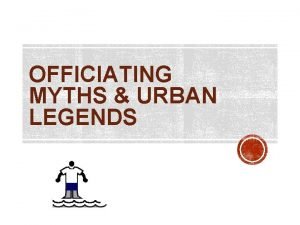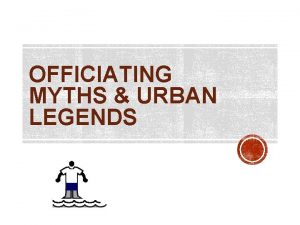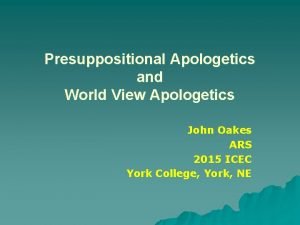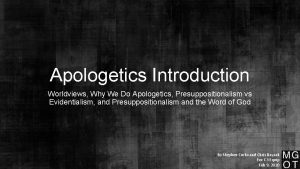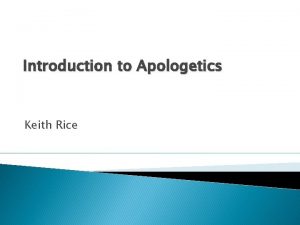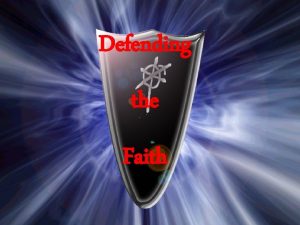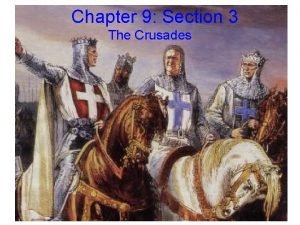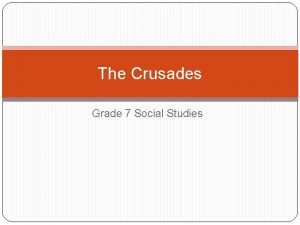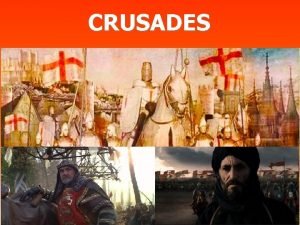Apologetics 101 Latter Crusades Myths Summary 4 th














































- Slides: 46

Apologetics 101 Latter Crusades, Myths Summary

4 th Crusade • Called by Innocent III in 1198. Innocent made the major goal of his pontificate to liberate the Holy Land. • Due to complicated European power struggles, the Crusade took awhile to start. • The spellbinding preacher, Fulk of Neuilly, and a group of inter-related nobles “saved” the crusade from never organizing.

4 th Crusade • Thibaut of Champagne hosts a knightly tournament, where he declares he will take the cross. His cousin Louis of Blois joins him, and many more follow suit. • A great council is held in 1200, with a sea-route decided upon, following the example of Richard I • The leaders decide to send emissaries to Venice, the great sea-fearing nation with a Crusading tradition.

Planned Route

Treaty of Venice • Venice is led by the 90 year old blind Doge, Enrico Dandolo. • The Doge agrees to provide a fleet, and the crusaders completely overestimate the size of the incoming army. • Venice suspends normal trade and operations for over a year, constructing a huge fleet to invade both Egypt and the Holy Land

Treaty of Venice • Venice agrees to transport 35, 000 soldiers, plus horses etc…while providing 1 year of provisions and 50 war galleys at no cost, provided they receive half of whatever is won. June 29 th, 1202 is the departure date. • Venice fulfills its part to the letter, over 500 ships! • Only 11, 000 soldiers show up, many of them late, and many went to different ports (Genoa, Pisa, Marseilles etc…). • The cost of 85, 000 marks was an enormous sum, and the crusaders were not even close to that amount (probably about 1/3).

Treaty of Venice • Dandolo could not renounce the debt, as Venice was a Republic, and to do so would bring about economic disaster to the city. • He proposes that the Crusaders help capture the city of Zara, which had rebelled against Veneitian rule, which would allow a postponement of the debt, and a partial repayment. • The Crusaders agree, but many are troubled they are fighting with Christian city (albeit rebellious) ruled by a Christian state (Hungary).

Siege of Zara • After a brief siege, Zara falls. The Pope excommunicates the crusaders for attacking Christians, but this is suppressed by both the nobles and church leaders on the crusade. • The rank and file grow restless, and the next course of action is hotly debated. • The crusade leader, Boniface of Montferrat, visits Swabia to meet a Byzantine claimant to the throne. .

Politics, Politics… • Alexios Angelos is a young (late teens) exile, as his father had been deposed from the throne by his uncle and blinded. • Alexios argues that he is the rightful ruler, and promises to richly reward the Crusaders, including helping the Crusade and paying off the debt to the Venetians. • Despite warnings from the Pope and others, the crusaders believe it is an offer too good to refuse.

Politics, Politics… • Dandolo is quite familiar with Constantinople, having served as an envoy there earlier in his career. • The crusade leaders sign a treaty at Zara promising to restore the young Alexios, and some of the other crusaders leave for the Holy Land or go home in disgust. • The Pope, fully aware of Alexios’ story, strongly warns against taking action, as just as such action might be.

Constantinople • When the fleet arrives at Constantinople, they parade young Alexios in front of the sea walls… • Instead of being welcomed, he is derided by the populace, and the crusaders begin to realize there is a problem. • The Crusaders being a siege of Constantinople in 1203 with small successes, and the “bad uncle” flees. Alexios’ dad Isaac II is reinstated, but the Crusaders demand Alexios be named co-emperor.

Constantinople • At first things go well, with Alexios making payments and giving valuable gifts, with the promise of a Byzantine army looming. • Eventually he finds out there isn’t enough in the treasury, and the people of Constantinople resent the Crusader presence and the gifts. • Because of his failed promises, the Crusaders feel justified morally to begin “paying themselves” in the countryside around Constantinople.

Constantinople • Alexios even has some of the precious silver and gold from the churches melted down, which causes an uproar. • The Crusaders attack a mosque set up in Constantinople for traders. The Venetians light a fire to cover their retreat, and a good portion of Constantinople is burned down, causing homelessness, and hatred for Alexios.

Constantinople • A conspirator nicknamed “Mourtzouphlos” because of his bushy mustache overthrows Alexios and strangles him. The Crusaders demand the new “Alexios V” to pay, and he refuses, and provokes them. • In April of 1204, the crusaders take Constantinople, and in spite of their leaders and clergy demanding a “Christian sack” the rank and file go nuts. • The behavior of the cruaders is deplorable, and much violence is committed against fellow Christians. The greeks had even expected an imperial ceremony honoring a new emperor, not a sack!


Constantinople • Innocent III is absolutely ashamed, as are some of the crusaders, so much so that chroniclers leave it out and many spend days in confession, some for heinous crimes. • This event completes the schism of the eastern and western churches. • Considered by many historians to be the lowpoint of the crusades. • The crusaders set up a “Latin Empire” that saps crusading energy and ultimately fails.

True Route



The Crusades of St. Louis • Louis IX (1214 -1270), considered by many to be the ideal Christian monarch. • Many places in the world named after him, including the city in Missouri. • Canonized as a saint by the church less than 30 years after his death, amazingly fast! • Beloved by the church, nobles, and the common people, which is why so many French monarchs are named Louis!

The Crusades of St. Louis • Along with Richard I the Lionheart, considered the perfect example of a chivalric king. • Known for being cautious and calculating, not as hot-headed as Richard. • He considered the act of capturing Jerusalem to be one of the greatest acts of devotion to Christ. (Richard thought of it more as the triumph of a Christian warrior). • Even his enemies considered him a man of integrity and justice, and as such his kingship became legendary.

The Crusades of St. Louis • Goes on two Crusades, sometimes numbered the 6 th and 7 th (some say 7 th and 8 th). • The first is in 1248 • Targets Egypt as the source of Islamic power (like the original 4 th idea, and the 5 th) in order to secure Jerusalem permanently. • The most well-planned and financed of all Crusades, with provisions stockipled, taxes levied, and a fleet built (and paid for)!

The Crusades of St. Louis • After wintering on Cyprus, Louis leads the attack on Damietta, Egypt, eventually to head for Cairo. • Taking the city rather quickly, Louis marches south (very carefully) to Mansurah. • His vassal, Robert of Artois, brashly defeats a Muslim camp, but then is crushed in the city. Louis takes both shores of the Nile, but the Muslims sever his shipping lines…

The Crusades of St. Louis • His army falls apart due to disease, heat, etc… • The sick and wounded are killed as they try to head back to the Med, other are told to convert or die. • Louis himself is captured, and only allowed to leave Egypt for the huge sum of 400, 000 bezants (a King’s ransom)! • Leaves for the Holy Land where he builds up and strengthens what is left of the Latin states, especially the port cities such as Acre. • He spends about 4 percent of his annual income in defense for the Holy Land for the rest of his life (about 10, 000 pounds).

The Crusades of St. Louis • After Louis leaves, the Mamaluke Baybars takes control of Egypt. • Probably the most brutal and violent ruler of the entire crusading era. • Very effective, but known for deceiving people into surrender and massacring them. • When he captures Antioch, the worst massacre of the entire era is committed (something ignored by modernist anti. Christians in the west).

The Crusades of St. Louis • Louis in his 50’s goes on Crusade again, in response to this bad news from the Holy Land. • Again, the crusade is extremely well organized, and the Kings of England Aragon (Spain) agree to join in. • The Aragonese fleet is destroyed by a storm, and the English are only partially present. • Louis decides to sail directly south to modern day Tunisia and takes the city (ancient Carthage).

The Crusades of St. Louis • Most believe he did this after hearing a rumor that the ruler wanted to convert to Christianity, but just needed protection. • This was a false rumor. • A massive outbreak of disease breaks out during the summer heat of 1270. • Louis himself dies because of this, and his body is carried back to France, where his tomb is destroyed in the French “wars of religion” (Three Musketeers era). • His failure makes crusading enormously unpopular. If he failed, who could succeed?

Death of St. Louis

St. Louis IX

Books on St. Louis • Louis IX and the Challenge of a Crusade: A Study in Rulership, by William C. Jordan • Saint Louis: Crusader King of France, by Jean Richard (translated from the French) • Saint Louis, by Jaques le Goff



10 Myths of the Crusades

Myth #1 Myth: The Crusades were unprovoked acts of aggression against a peaceful Islamic world. Truth: The Crusades were primarily defensive wars responding to centuries of Islamic conquests (2/3’s of Christendom), the threat to Christians in Byzantium, the harassment of pilgrims, the desecration of holy places, and dhimmi status. They were considered an act of love and liberation.

Myth #2 Myth: The Crusades were fought for land, loot, and converts. Truth: Crusading was enormously expensive, and only worked because Europe was in an economic uptick. Most thought the liberations would go back to Byzantium, and most went home when the pilgrim’s vow was fulfilled. Forced conversions were never official or common, and most came away economically poorer.

Myth #3 Myth: Those who went on Crusade were “landless younger sons” or the economically challenged. Truth: The Crusades were a family affair, led by the lords of great estates and some of the richest families in Europe. Kings would eventually go, and impoverish themselves in the process.

Myth #4 Myth: The Crusader Kingdom’s were “our first colonies. ” (Karen Armstrong) Truth: Only by the loosest definition of “colony” can this even be feasible. The Crusader kingdoms were independent political entities, and the transfer of wealth went from west to east! If colony means a different culture, than every conquest or political change is a colony. Colony is not the equivalent word of settlement.

Myth #5 Myth: The Crusades were led by European darkaged barbarians that victimized the enlightened Islamic culture. Truth: The whole idea of a “dark ages” is a myth invented during the modernist European Enlightenment to make the church look bad, and this narrative was appropriated by Islamists in the 20 th century. Most of what we call Islamic culture is the culture of the conquered peoples given Arabic names, and Europe made its leap forward during this era, especially in the areas of agriculture, military technology, jurisprudence, animal husbandry, and the like.

Myth #6 Myth: Saladin is the epitome of a non-Christian ruler. Truth: Saladin was forgotten in the Arab world because he ultimately failed, and the western memory is based on romantic tales to have a chivalrous counterpart to Richard I. This romantic version is the current view of Arab and Islamic nationalists (he was also Kurdish). He was known for being obsessed with jihad more than anything, and the non-massacre of Jerusalem is the exception, not the rule for Saladin.

Myth #7 Myth: The Crusades are one of the main reasons for Islam vs. the West animosity today. Truth: This is only true in the sense that the “long memory” of the Crusades is an invented memory, given via true European colonialism during the 19 th century, when the colonial powers pointed to the Crusades as a precursor. Because of the decay of the Turks, the Crusades were a convenient source of blame. This invented memory is now used in the Islamic world, and even believed by some Christians who go on apology tours.

Myth #8 Myth: The Crusades were the direct cause of the decline of the Islamic world. Truth: The Turks in particular would reach a peak hundreds of years later, threatening Vienna twice! It was only in the 16 -1700’s that the true decline started to take place, mostly due to Ottoman corruption and European economic and technological advantages.

Myth #9 Myth: The Crusades were led by power-mad Popes. Truth: While some may have secretly (or even openly) wished to re-unify the Eastern and Western churches, most truly believed that Islam was a threat to the west, and most were reforming monks concerned with purifying the church through discipline and penance. As medieval Christians, the liberation of Jerusalem and the defense of Christendom was part of being a successor to Peter and watching over the flock, and acting out of love for eastern Christians.

Myth #10 Myth: The Crusades are the leading example of religious intolerance Truth: This reads into the past modernist ideas of pluralism and democracy, and says “more about the observer than the observed. ” The medieval Crusader would have been equally or even more shocked by the “infinitely more destructive wars waged for the sake of political and social ideologies. ” (Madden, New Concise History,

The Popular Narrative? “The Crusades are generally portrayed as a series of holy wars against Islam led by power-mad popes and fought by religious fanatics. They are supposed to have been the epitome of selfrighteousness and intolerance, a black stain on the history of the Catholic Church in particular and Western civilization in general. A breed of protoimperialists, the Crusaders introduced Western aggression to the peaceful Middle East and then deformed the enlightened Muslim culture, leaving it in

God’s Battalions “The thrust of the preceding chapters can be summarized very briefly. The Crusades were not unprovoked. They were not conducted for land, loot, or converts. The crusaders were not barbarians who victimized the cultivated Muslims. They sincerely believed that they served in God’s battalions. ” –Stark, 248.

Personal Info Email: aarondhayes@gmail. com Web/blog: hayesworldview. wordpress. com Powerpoint/notes will be available on website
 Conversational apologetics michael ramsden
Conversational apologetics michael ramsden Moral apologetics
Moral apologetics Types of apologetics
Types of apologetics Apologetics
Apologetics Conversational apologetics
Conversational apologetics Apologetics
Apologetics Offensive apologetics
Offensive apologetics Purpose of the latter rain
Purpose of the latter rain Ladder conversion
Ladder conversion Latter’s
Latter’s Friendly business letter format
Friendly business letter format Analyserende artikel latter
Analyserende artikel latter Latter
Latter What is a crusade
What is a crusade How did the crusades change europe
How did the crusades change europe The crusades were military expeditions undertaken by
The crusades were military expeditions undertaken by Crash course crusades
Crash course crusades The crusades were military expeditions undertaken by
The crusades were military expeditions undertaken by Chapter 12 lesson 3 culture of the middle ages
Chapter 12 lesson 3 culture of the middle ages What were the goals of the crusades
What were the goals of the crusades Crusades recruitment poster project
Crusades recruitment poster project Crusades recruitment poster
Crusades recruitment poster Crusades recruitment poster ideas
Crusades recruitment poster ideas The crusades webquest
The crusades webquest Lesson 2 the crusades
Lesson 2 the crusades Crusades through arab eyes
Crusades through arab eyes Crusades recruitment poster project
Crusades recruitment poster project Crusades
Crusades Crusades used in a sentence
Crusades used in a sentence What were two indirect results of the crusades
What were two indirect results of the crusades The crusades a jigsaw activity answer key
The crusades a jigsaw activity answer key Church reform and the crusades
Church reform and the crusades Chapter 14 section 1 church reform and the crusades
Chapter 14 section 1 church reform and the crusades Origin myths definition
Origin myths definition Turkish myths and legends
Turkish myths and legends Flower myths: narcissus, hyacinth, and adonis
Flower myths: narcissus, hyacinth, and adonis Software myths
Software myths Poland urban legends
Poland urban legends Myths about pirates
Myths about pirates Myths about comets
Myths about comets 5 myths about attic ventilation
5 myths about attic ventilation Legends and myths difference
Legends and myths difference Myth legend fable
Myth legend fable Myth legend fable
Myth legend fable Example of folktale
Example of folktale Myths and legends of king arthur
Myths and legends of king arthur Hediod
Hediod

